Displaying items by tag: SOY
Ireland's Sailing Successes Celebrated In Historic Setting
#soy – Yesterday's Afloat.ie/Irish Sailing Association annual sailing awards ceremony saw a remarkable gathering of talented boat people and their supporters and friends at the Royal College of Surgeons in Ireland in Dublin to honour the Best of the Best in company with Minster for the Marine Simon Coveney. The Sailor of the Year title went to Anthony O'Leary of Cork and our all-conquering Commodore's Cup team, while the Youth Sailor of the Year is Laser Gold Medallist Finn Lynch of County Carlow, who currently sails from the National Yacht Club in Dun Laoghaire, but started his stellar sailing career with the lakeside Blessington Sailing Club up in the Wicklow Hills.
In addition, Mayo Sailing Club was chosen from upwards of 80 training centres – both clubs and commercial ventures – as the Training Centre of the Year, while the venerable Royal Cork Yacht Club, currently led by Admiral Pat Lyons, assumes the mantle of ISA/Mitsubishi Motors Sailing Club of the Year 2015 in continuation of an informal pioneering inter-club contest - dating back to 1979 - which will resume its long-established tradition of a proper handover ceremony for the coveted ship's wheel trophy in the winner's Crosshaven clubhouse as the new season gets fully under way.
Meanwhile, Afloat's W M Nixon performed as MC in yesterday's ceremony, and in doing so he was assisted by the discovery that the venue had unexpected historic links with some of the great figures in Irish sailing history, as he now explains.
The fine building of the Royal College of Surgeons in Ireland adds a bit of real class to the west side of St Stephen's Green, and it's almost exactly at the point which most of us think of as the absolute centre of Dublin, the very heart of the city where Grafton Street winds away from the Green's northwest corner.
Yesterday afternoon it became the heart of Irish sailing too, and we struck purest gold after reflecting that the only President of the RCSI of whom we had any knowledge of a strong sailing connection was Sir Thomas Myles.
Thomas Myles (1857-1937) was one of those larger-than-life characters who completely upset our perceptions of the Victorians as self-effacing and quiet people of an overly religious disposition. A Limerick Protestant who wore his faith lightly, he was a Home Rule supporter from an early age, and while studying medicine at Trinity College in Dublin he became a university boxing champion of such continuing power that at the age of thirty he went three rounds with the legendary prize fighter John L Sullivan.
Sailing was among his many sports, and as his reputation and income grew with his success as a surgeon, so too did the size of the yachts which he sailed from the Royal Irish Yacht Club on Dublin Bay. By the 1890s he was one of the most eminent surgeons in the city, and in a contest at the turn of the century he stood as firm favourite for the election to be the President of the Royal College of Surgeons in Ireland for the period 1900 to 1902.
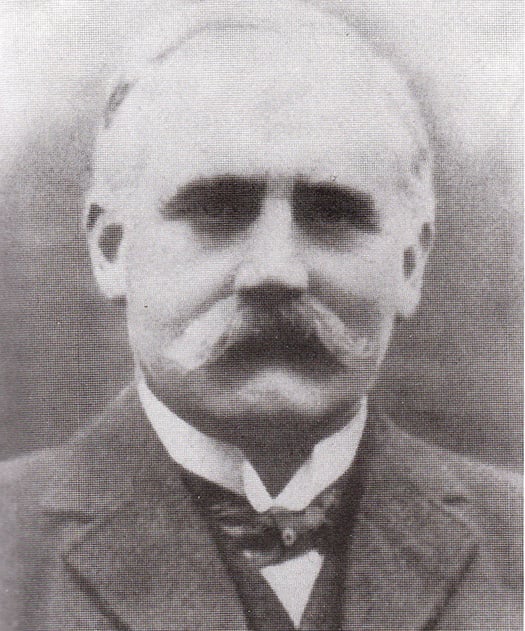
Thomas Myles around the time he was President of the Royal College of Surgeons in Ireland
But his opponent, one Dr Henry FitzGibbon, refused to accept the situation on the grounds that Myles' public involvement with the United Irish League would bring disrepute upon the college, and he went to court to argue his case that Myles shouldn't be allowed to stand for election in the first place .
Now it so happened that another keen sailing man, Walter Boyd of Howth (his son was to design the Howth 17s), was the judge who heard the case. Boyd is best known for his twelve years as a bankruptcy judge which resulted in the phrase "breaking Boyd's heart" becoming Dublinese to describe profligacy as referenced in Joyce's Ulysses. But in 1897 he had returned to more general cases, thus it was Boyd who heard the FitzGibbon/Myles case, and he threw out the plaintiff's arguments with such vigour that FitzGibbon was obliged to publish apologies and withdraw his candidature.
So when Thomas Myles became the president of the RCSI in 1900, it was an elevation which received much more than the usual attention around town. And in a style typical of the man, he set in motion the process whereby the College started to build itself the Grand Banqueting and Examination Hall, which is where the great and the good of Irish sailing were assembled yesterday.
The impressive new hall wasn't fully finished until 1904, but by that time its instigator had become Sir Thomas Myles Bt, as was the custom with retiring Presidents of the RCSI. Having seen the new building works under way, his retirement from office - though not from working as a surgeon - meant he'd more time on his hands, so he bought himself a great big ketch, the 121-ton Dorothy, which he cruised on the coasts of Europe.
But by 1910 or perhaps even earlier, he had downsized to the more workmanlike and manageable 60ft Chotah, which had been built in Brixham in Devon in the 1890s and was apparently not unlike a Brixham trawler, for the ever busy Wally McGuirk of Howth has discovered that she ended her days as an Arklow fishing boat.
The reason Wally and others are so interested in Chotah is that she is the missing link in the 1914 Howth and Kilcoole gun-runnings. We know all about the "flagship" of that event, Erskine and Molly Childers' Asgard, we know too about Conor O'Brien's ancient ketch Kelpie and have photos of her as well, and we even know a little bit about the Nugget, the McLaughlin family's boat which was the first fishing boat in Howth to be fitted with an engine.
But of the Chotah we know very little at the moment, but hope that the newfound Arklow connection will discover a photo. What is known is that when the gun-running committee sought to find a suitable vessel with auxiliary power to take over the cargo of 600 guns from Conor O'Brien's engineless Kelpie in order to land them on the beach at Kilcoole in County Wicklow, that pillar of society Sir Thomas Myles willingly agreed to bring Chotah in on the action. He and his crew took aboard the guns off St Tudwal's Island just south of Abersoch on the Welsh coast, and brought them across Channel to land at Kilcoole a few days after Asgard had made her much more high profile landing at Howth.
If you find all this insurgency activity by significant figures in Irish society a bit bewildering to comprehend in all its complexity, you ain't heard nothing yet. The Great War broke out just a few days later, and in a general mobilization Sir Thomas Myles Bt was soon appointed to being a Lieutenant Colonel in the British Army in order that he could head up a large Royal Army Medical Corps medical and surgery unit in his hospitals and in the field.
Then in November 1914 – barely three months after he had been personally involved in smuggling guns into Ireland while evading the surveillance of His Majesty's Armed Services – Sir Thomas Myles was appointed Honorary Surgeon to King George V. Yet it's said that when the 1916 Easter Rising took place, he readily found the facilities to treat any wounded rebels, and even managed to hide those on the run in the rabbit warrens of hundreds of rooms which were to be found in the great Dublin hospitals under his supervision.
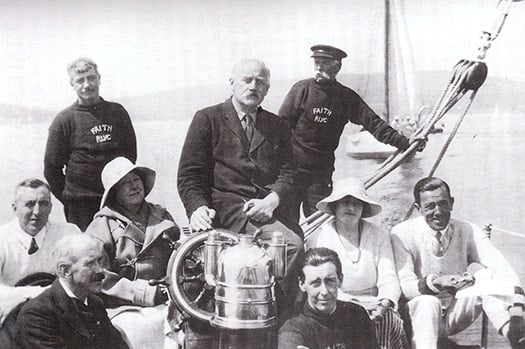
Pillar of society. Sir Thomas Myles sailing with family and friends aboard his cutter Faith in the 1920s. Photo courtesy RIYC
So if you happened to notice me looking around in some wonderment at the stately and ordered design of the Banquetting Hall in the Royal College of Surgeons yesterday afternoon while I reflected on the man who had caused this very fine room and the handsome edifice about it to be built, now maybe you'll understand why. Yet such is the complexity of Irish sailing in its myriad of forms that it's arguably all of a piece with the extraordinary lifepath of people like Sir Thomas Myles, and the ISA President's speech captured some of the problems people face in trying to administer this weird sport of ours.
The new Sailor of the Year Anthony O'Leary wasn't present for the awards as he is currently in the midst of a long-planned sailing campaign in Florida. But for the actual handover, his place was well taken by his son Robert and RORC Commodore Michael Boyd, who was co-skipper of Quokka in the successful Commodore's Cup team.
Things could have become completely surreal as the President himself, David Lovergove, wasn't at the event as his flight home from America the day before had been cancelled because of exceptionally heavy snowfalls on the US East Coast. But ISA Board Member David O'Brien of Cork of gallantly stepped up to the plate to fulfill the Presidential role, and made a fine job of delivering a speech which well encapsulates what the day was all about:
"Flag Officers, distinguished guests and fellow sailors, you are all very welcome here this afternoon. In looking out over this friendly assembly - some of whom I know very well, many of whom I know quite well, and some of whom I don't know at all but am looking forward very much to meeting – it is clearly obvious that the sailing and boating community in Ireland is one of enormous diversity.
In fact, in thinking of the sheer range and varying levels of activities afloat which we in the ISA try to represent, I am reminded of President de Gaulle's exasperated comment about the difficulties inherent in trying to govern France: "How can you administer a country" demanded the frustrated General "which has two hundred and forty-six varieties of cheese?"
Our fellow members of the Irish sailing and boating community may well think that we on the Board of the Irish Sailing Association tend to see ourselves as the big cheeses among the many varieties. Believe me, nothing could be further from the truth. Like yourselves, we could be described as the small artisan cheeses of sailing, with a strong local flavour. But it happens that it has fallen to us on the Board at this time, to undertake the task of re-shaping the Irish Sailing Association as it emerges rather bruised from the economic recession, and we need your help.
So I would ask you to be sympathetic to us in the administration of the Irish Sailing Association as we work to re-form our structures and implement our new Strategic Plan 2015-2020. It has been most encouraging the way that the Public Consultation Meetings in Dun Laoghaire, Cork and Galway in recent weeks have been so well attended, and from them we have gained very useful insights to work with you towards a productive, worthwhile and groundbreaking ISA Annual General Meeting on March 28th.
But that's another day's work. This afternoon, we are here for a celebration to honour Irish sailing and its many successes both individually and in team efforts through 2014. This function began as a thought in my mind when, during last summer, we were getting reports of fantastic results being achieved by Irish sailors and I felt that we, as the Board of the ISA, should recognize these achievements in some way. A reception was considered, then as Summer progressed and incredible achievements continued to roll in, I realized that such receptions would almost need to be held on a weekly basis.
So it was decided to wait until year end and combine the celebration of Irish sailing achievements with the presenting of the awards. Yet even that is a cause of concern. You see, in looking over the extraordinary listings for 2014, for the life of me I don't see how 2015 can even begin to match it. But as with 2014, doubtless this year will also produce some very welcome good news stories, and we look forward to the new season very much indeed, with the confidence that Ireland will continue to punch well above its weight in the world of sailing.
The structure of this afternoon's awards ceremony will help you to form a comprehensive picture of the entire Irish sailing and boating scene. Most appropriately, we will begin with the award for the ISA Training Centre of the Year, which we reckon to have been the best in 2014 from a lineup which includes an impressive 80 training facilities, run both in clubs, and as commercial ventures.
It's also worth noting that there are now 24 secondary schools in Ireland, which include sailing as a sports option in their curriculum. A while ago, I visited Schull Sailing School and was bowled over by the fact that the children in the local school select sailing as their sport of first choice, ahead of rugby, soccer, Gaelic football, hurling, hockey etc. Now that is some achievement. This is clearly a step in the right direction, and it leads us to the next part of our ceremony, the award for the ISA Youth Sailor of the Year.
Having laid the foundations, so to speak, we then move on to the announcement of the ISA/Mitsubishi Motors "Sailing Club of the Year" award. The demographics and population spread of Ireland are such that our sailing clubs play the key role in most of our sailing development, and as we had the world's first sailing club in 1720, our clubs are literally world class.
We not only invented sailing clubs, but back in 1979 we became the first sailing country in the world to have an informal "Club of the Year" competition. Since 1986, it has been sponsored by our very good friends of Irish sailing at Mitsubishi Motors.
We feel that today's national gathering is the appropriate time to announce the winner, which will be known as the Sailing Club of the Year 2015. But in time-honoured tradition, as the new season gathers pace, there will be another ceremony in the winning clubhouse for the full and final handover of the historic ship's wheel trophy, when the members can share in the successes obtained by their top competitors and administrators.
With this framework of Irish sailing clearly in place, we then conclude with the peak of achievement, the ISA/Afloat "Sailor of the Year 2014". Afloat's ownership of this award – based on Sailor of the Month winners - has a long history, going back to 1996, and it successfully highlights achievement in every area of sailing.
One month, you might get an exceptional voyage honoured, while the next month it might be a major international dinghy championship victory. The diversity is total. And just occasionally, to emphasise that we are a community, which functions afloat and ashore, the monthly award might go to someone who has given selflessly of their time for sailing administration.
The overall national award will be presented to the person who, in the judges' opinion, achieved the most notable results in, or made the most significant contribution to Irish sailing during 2014.
The boating public has had a chance to nominate their top three through an online poll, Afloat.ie got a vote too and the Sailor of the Year judges have decided the final winner.
I cannot conclude without acknowledging our sponsors. In addition to those mentioned here today – Dublin Port, Parasol and Mitsubishi Motors - I also want to thank Providence Resources for their contribution to the high performance squad. However, it is the incredible support that we receive from the Irish Sports Council that allows us to function and without whose support we would not have nearly as much to celebrate today as we have. Year after year the Sports Council continues to support sailing and behalf of Irish sailors, I thank you most sincerely".
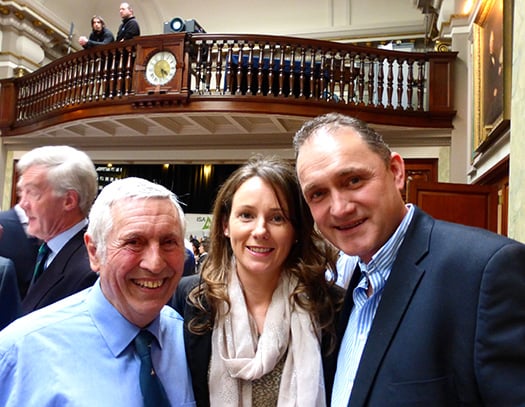
The men who raced the open ocean. At the reception in the RCSI were (left to right) Dickie Gomes (Sailor of the Month for May 2014), Caroline Coyne, and her husband Liam Coyne (Sailor of the Month for August 2014). Both Dickie and Liam have sailed short-handed Round Britain and Ireland Races with success, the former in 1982 and the latter in 2014. Liam Coyne topped the Afloat.ie online poll for 2014. Photo: W M Nixon

Josephine Keller, Aisling Keller, Ann Carroll, Nicole Hemeryck and Oisine Hemeryck
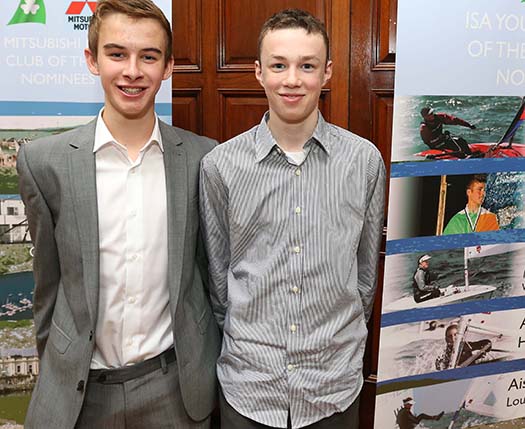
Conor Quinn and Adam D'Arcy

Pat O'Neill and Charles Seargent
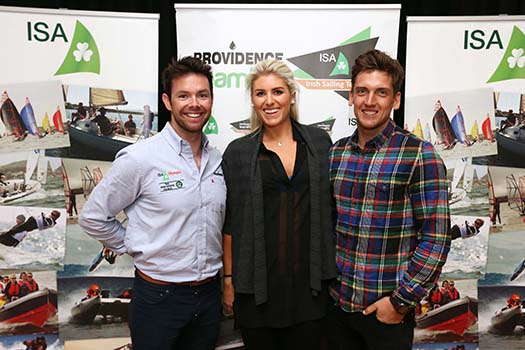
Matt McGovern, Ryan Seaton and Saskia Tidey
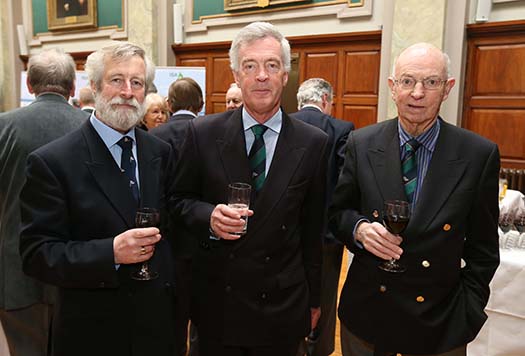
Charles Sargent, Brian Craig and Paddy O'Neill

Jack Roy, David Vinnell, and Ron Hutchieson
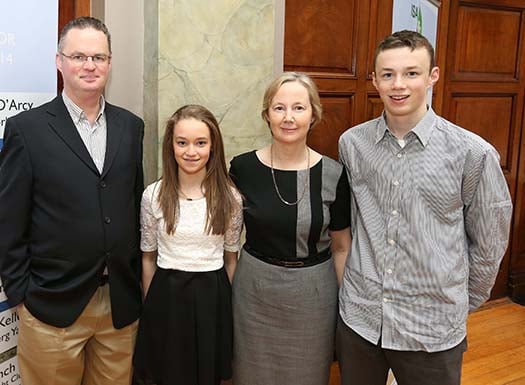
John D'Arcy, Kate D'Arcy, Imelda D'Arcy and Adam D'Arcy
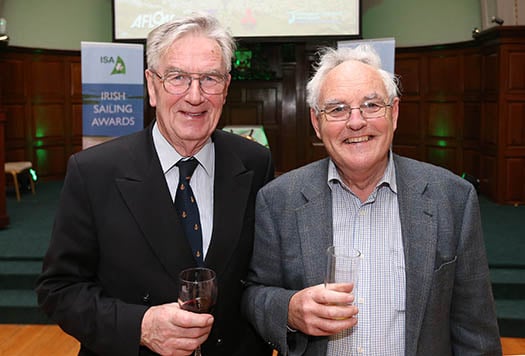
Hal Bleakley and Padraic O Brolchain

Ian Dickson, Andy Johnston, Jim Lampkin and Jane Johnston
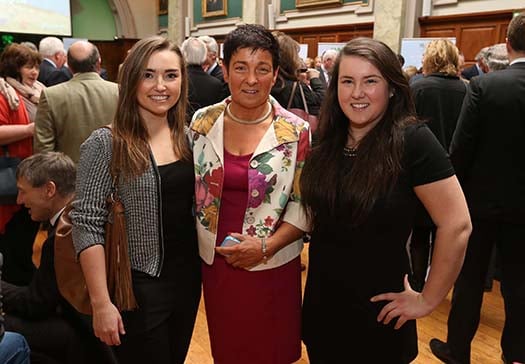
Isabella Morehead, Claire Burke and Muireann Guifoyle

Tony O'Driscoll and David Metcalfe
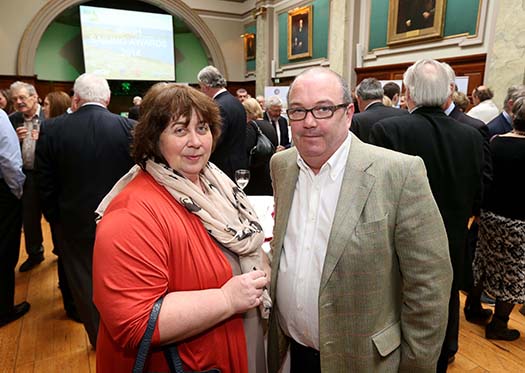
Sandra Wynne and Edwin Fay
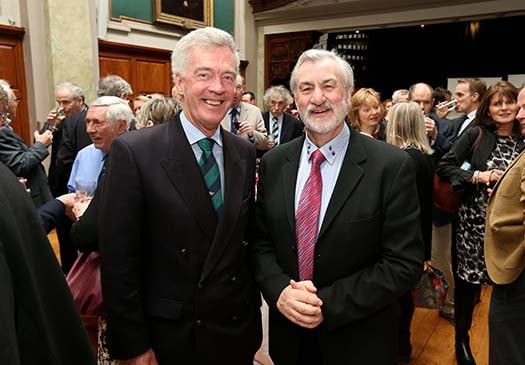
Brian Craig and Kieran Mulvey, Chairman, Irish Sports Council






























































